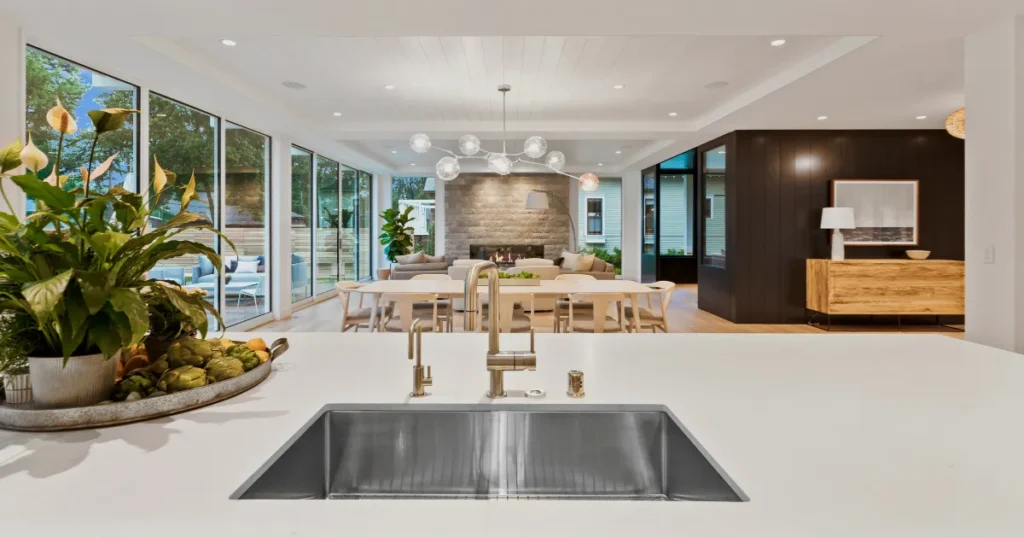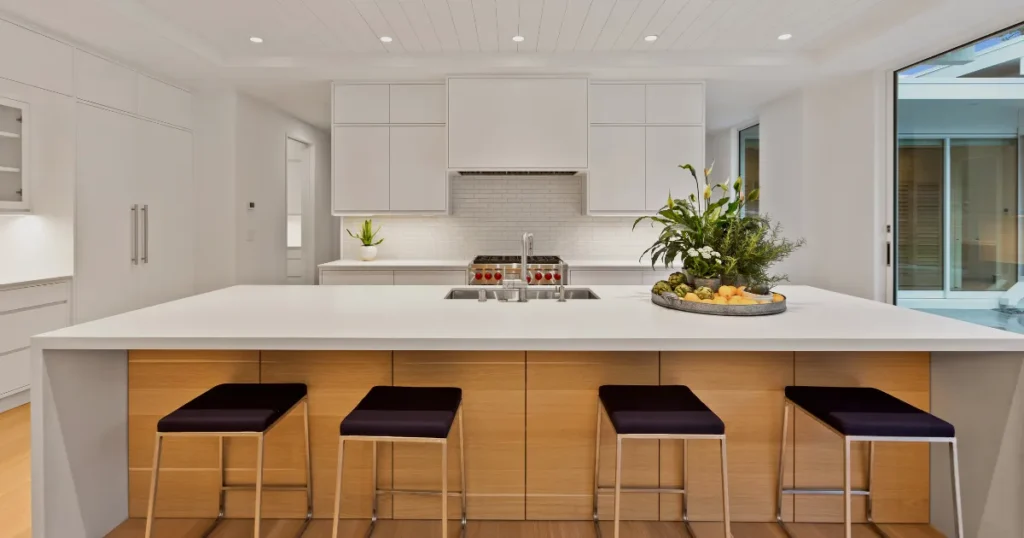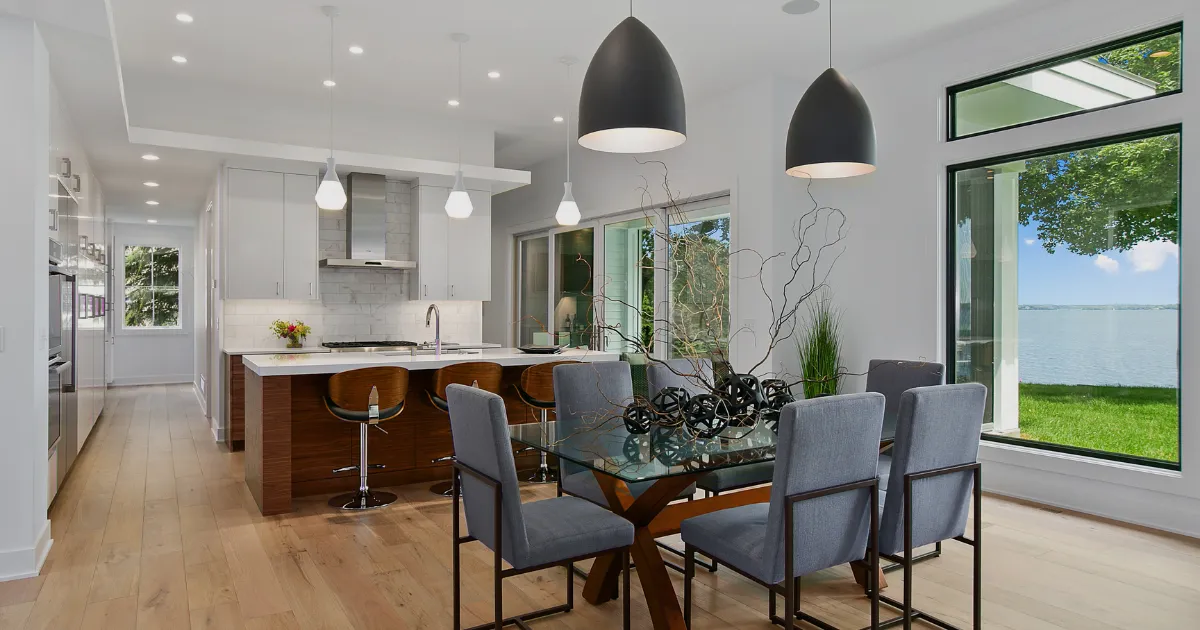Picture this: It is evening and you are in the kitchen to cook dinner for your family/ friends, only to find the room very dark such that it is hard to do a good job. Frustrating, right? That is how recessed lighting comes into the picture and helps in such a situation. Not only does it provide excellent illumination, but it also adds a sleek, modern touch to your kitchen decor.
It provides a neat and intuitive output that supports most aesthetics found in kitchens of all the various styles. In this blog post, we’re going to discuss how to layout recessed lighting in your kitchen – so you can get the best of both style and utility.
What is Recessed Lighting?

Before we dive into the layout specifics, let’s quickly cover what recessed lighting is and why it’s so popular in kitchens.
Recessed lighting refers to those light fixtures that are installed into a depression within the ceiling; they are also known as can lights or downlights. When installed, it gives the feeling of light coming from a hole in the top of the ceiling, and so directs most of the light downwards.
Advantages of Recessed Lighting in Kitchens
- Space-Saving Design: Recessed lights are installed within the ceiling, and therefore, this option leaves no room on the ceiling, which, in turn, does not make the room look cluttered.
- Versatility in Placement: They can be installed nearly everywhere so they are suitable for use in areas such as over the countertops, sinks or islands.
- Modern and Clean Aesthetic: Recessed lights give a modern outlook that complements almost all styles of Kitchens.
Plan Your Kitchen Lighting Layout

Having a basic understanding of the concepts, let’s dive into specifics of how to approach the planning of kitchen lighting layout.
Step 1: Assess Your Kitchen Space
The first essential procedure towards coming up with the right recessed lighting placement for your kitchen is to evaluate your premise well. Consider the following:
- Kitchen size and shape
- Ceiling height
- Natural light sources (windows, skylights)
- Task areas (countertops, sink, stove)
- Focal points (kitchen island, artwork)
Measuring your kitchen area is very important before installation, and as such, you should ensure you’ve taken measurements of the kitchen and drawn a rough sketch or floor plan. This shall go a long way in helping you when determining your lighting layout.
Step 2: Determine Your Lighting Needs
Next, think about the different types of lighting you’ll need in your kitchen:
Task Lighting: This brings out lighting in the working areas, such as the preparation of food and washing of dishes.
Ambient Lighting: An important function of this type of light is to offer general lighting for the entire room.
Accent Lighting: Highlights specific features or creates atmosphere.
Step 4: Choose the Right Recessed Lights
Now that you know where to place your lights, let’s talk about choosing the right fixtures.
Size Matters
Recessed lights come in various sizes, typically ranging from 3 to 6 inches in diameter. Here’s a quick guide:
- 3-inch: Ideal for accent lighting or small spaces
- 4-inch: Good for task lighting and smaller kitchens
- 5-inch: Versatile size suitable for most kitchen applications
- 6-inch: Best for high ceilings or large, open kitchens
Trim Options
The trim is the visible part of recessed light in the kitchen. Consider going for a style that complements your kitchen decor:
- Baffle Trim: Reduces glare and works great all the time
- Reflector Trim: Maximizes amount of light emitted, favored in case of high ceilings
- Adjustable Trim: Can direct light precisely where it is required
- Wall Wash Trim: Good for displaying walls or even pieces of art
Bulb Choices
LED bulbs are the most energy-efficient and long-lasting option for recessed lighting. Consider the following when selecting bulbs:
- Color Temperature: 2700K to 3000K is okay for a warm, friendly environment
- Lumens: 800 to 1200 lumens per fixture is usually enough for kitchen use
- Dimmability: Stick with dimmable bulbs to have better control of your lighting.
Step 4: Install Recessed Lighting
Even though it is possible to install basic electrical fittings yourself, one should pay attention to hiring an expert for this kind of work because of the need for proficiency in handling power cables.
Where to Place Recessed Lights in Kitchen
Now that we’ve laid the groundwork, let’s explore where to place recessed lights in your kitchen for optimal illumination.
General Kitchen Area
For general ambient lighting, it is advisable to space your recessed lights between four to six feet apart. Begin from the middle of the room and move outwards. This way, all areas will have similar brightness.
Pro Tip: The amount of lights required can be worked using a formula that involves multiplying room size by 1.5. It would give you the total wattage needed; the next step would be to divide this number by the wattage of bulbs that you intend to use.
Task Areas
When it comes to task lighting, you’ll want to focus on the areas where you’ll be doing most of your work:
Countertops
Place recessed lights about 12 to 18 inches away from the wall, centred over the edge of the countertop. This will offer some lighting for cooking but no dark patches.
Sink Area
Install a light directly over the sink to ensure you have plenty of illumination for washing dishes and cleaning.
Stove and Cooktop
Position lights slightly in front of the stove or cooktop rather than directly over it. This will light your cooking area without creating glare on shiny surfaces.
Kitchen Island
For kitchen islands, the lighting approach depends on the size and shape of the island:
- For small islands, two to three recessed lights evenly spaced should suffice.
- For longer islands, use one light for every 4 to 6 feet of length.
- Consider adding pendant lights in addition to recessed lighting for a more dramatic effect.
Accent Lighting
Don’t forget about accent lighting! Use recessed lights to highlight:
- Open shelving
- Artwork or decorative elements
- Glass-front cabinets
Sample Layout For Recessed Lighting
Let’s put all this information into practice with a sample layout for a 12′ x 15′ kitchen with an island:
- General Lighting: Install 6 recessed lights in a grid pattern, spaced about 5 feet apart.
- Countertop Lighting: Add 3 lights along each major countertop run, positioned 12-18 inches from the wall.
- Sink Area: Place 1 light directly over the sink.
- Stove: Install 2 lights slightly in front of the stove.
- Island: Use 3 recessed lights spaced evenly over a 6-foot island.
- Accent Lighting: Add 2 lights to highlight open shelving or artwork.
Common Mistakes to Avoid
- Over-Lighting or Under-Lighting: Do not install too many or too few lights, as either can result in a poorly lit kitchen.
- Ignoring Task Areas: Make sure there’s enough light in every key work area to prevent shadows and improve safety while cooking.
- Improper Spacing: Incorrect spacing can lead to uneven lighting, with some areas being too bright and others too dim.
- Neglecting Dimmer Switches: Installing dimmer switches allows you to adjust the light intensity based on the time of day and activity, providing greater control over your kitchen’s ambience.
Frequently Asked Questions
How many recessed lights do I need for my kitchen?
The number of recessed lights needed depends on your kitchen’s size and layout. A general rule is one light for every 4-6 square feet of ceiling space.
Can I install recessed lighting in an existing kitchen ceiling?
Yes, it’s possible to install recessed lighting in an existing ceiling, but it may require cutting into the drywall. Consult with a professional electrician for the best approach.
What’s the difference between IC-rated and non-IC-rated recessed lights?
IC-rated lights are designed to come into direct contact with insulation, while non-IC-rated lights require a gap between the fixture and insulation for safety reasons.
What is the ideal distance for placing recessed lights from the kitchen wall?
It is best to keep the kitchen wall approximately 12 to 24 inches away from the location of the recessed lights. This arrangement helps to eliminate shadows and provides constant illumination for countertops or other surfaces. Such dimensions may differ a little depending on the height of the ceilings and light desires.
Final Words
A well-planned recessed lighting layout is essential for a functional and beautiful kitchen. By considering your specific needs and carefully planning the placement of lights, you can create a space that is both practical and visually pleasing.
Lighting can make or break a kitchen’s atmosphere and functionality. Take the time to plan your recessed lighting layout carefully, and you’ll reap the benefits every time you step into your kitchen.
